| JESUS' PUBLIC MINISTRY AND PREACHING
Regarding the commencement of Jesus' public ministry Luke states that "Jesus himself was about thirty years old when he began his ministry" (3:23). His appearing took his contemporaries by surprise in every respect. The Temple guards who were later to take him prisoner and who were accustomed to hearing the teaching of the learned in the collonades of the sanctuary, testified that, "No-one ever spoke the way this man does" (John 7:46). In his teaching Jesus often concentrated on describing who he was and why he had come into this world, trying to forge a personal disciple-relationship with his hearers. Although there was no denying the fact that he performed miracles, he went as far as to rebuke those who considered them of primary importance. It would seem that he himself tried consciously to avoid the appellation 'Messiah' because of the political liberation it implied. Thus we are told that even John the Baptist doubted his Messiahship. John, of the opinion that the Messiah would "thoroughly purge his threshing floor" and "burn up the chaff with unquenchable fire", sent messengers from the prison to ask Jesus, "Should we expect someone else?" Jesus commanded them to report to John what they had seen and heard:
The gospels bear more resemblance to a painting than to a photograph. Each of the chroniclers of Jesus' life gives his own peculiar emphases, thus complementing the picture drawn by the others. If we add up all the complete narratives and events we have a collection of over 360 "snaps", which can themselves be divided up into yet smaller details. How much film may have been edited out of this selection of snaps we cannot say, but of no other Jewish Rabbi have we such extensive knowledge. We might say, to use a Jewish figure of speech, that no other even "comes up to his ankles". And yet the gospels are but a summary of three full years of activity. Jewish critics often have the power of seeing things which remain hidden from us. C.G. Montefiore, elected president of the Liberal Jewish World Movement in 1926, made some noteworthy observations in his book "The Synoptic Gospels". If Jewish scholars sometimes argue that there is nothing new -- "nihil novi" -- in the gospels, or that their message is but over-excited, abnormal idealism, the critic should be wary of doing exactly the opposite - he must be careful not to "lose and suffocate their drive for idealism, their impulsive power and paradox".
Montefiore considers three sayings of Jesus to form the very heart of the gospel:
2."I have not come to call the righteous, but sinners to repentance" (Luke 5:32). 3."For the Son of Man came to seek and to save what was lost" (Luke 19:10). In music four-part harmony results from the simultaneous sounding of four separate melodies. Likewise, the mystery of Jesus' life has so many aspects that all four gospels are needed for its description. Earlier,3 we drew attention to the fact that in the "idiographic" humanities we ought to strive, as in the basic endeavour of the topika, to find the "leading points of view" of the issues, and their significance and "place" (Greek topos) in man's understanding. This entails some kind of "topographic" mapping-out in which the aim is to conceive the significance of the details in the whole landscape. Some critics, both Jewish and Western, have indeed tried to envisage the various stages of Jesus' activities in the form of a map.4 All of these attempts are, however, but some kind of "helping lines" which, as time goes on, assist the artist in projecting onto paper the final picture. Nevertheless, without these lines there will be no picture. The synoptic gospels, Matthew, Mark and Luke, depict Jesus' ministry as the climax of salvation-history and concentrate on describing the last year of his life. With only the information provided by these three it would not be possible to build up a geographical sketch of his itinerary. John's gospel, on the other hand, provides us with details of the geography of Palestine, and justifies drawing a picture of the various stages of Jesus' three and a half year public ministry. With this kind of "topographical" work different opinions may be entertained regarding details and the mode of presentation. It resembles an orienteering competition in which all the competitors have gone astray at one of the checkpoints. But only he who has himself poured out his sweat onto the terrain knows just what the paper landscape put into his hand, the map, actually looks like in reality. A calm study of the motivating factors behind the gospels reveals many of the modern, free-thinking interpretations current to be utterly baseless. The miracle of the feeding of the 5000, for example, has been explained as a lesson in unselfishness by the disciples and the ordinary people to the rich who were present - they simply shared with their neighbours the food they were carrying in their cloaks, and lo and behold, in no time at all everyone had plenty to eat! Jesus "walking on the water" was nothing more than an illusion - he was walking along the shore and the anxious disciples in the boat thought in the mistiness that he was an apparition. At Jesus' call, Peter threw himself into the water and Jesus pulled him onto dry land. When the disciples had taken Jesus into the boat and circled round to the other side of the mountain, they passed from the epicentre of the storm and thought that he had subdued the elements. Similarly when he slept during the storm and the disciples awakened him - they simply sailed round the mountain and reached shelter from the winds of the plains. And so the explanations go on. As we can see from map No. VIII below, the miracle of the feeding of the five thousand took place on the eastern side of the Sea of Galilee. It was Spring or early Summer and there was "plenty of grass" (John 6:10 and Matt. 14:19). This is typical of that time, particularly in the valley of El Kursi where the miracle took place. Around half past six in the evening the western side of the lake falls into the shade, at which warm air rises and a furious squall forces its way through the "Valley of Doves" from behind Mount Arbela to the lake. That unexpected wind once carried some inexperienced young Bible camp students towards the Syrian shores on the eastern side, where they would most certainly have met their deaths if a police speedboat had not reached them in time. Fishermen never venture onto the lake in the evening. Jesus sent his disciples from this eastern shore in the direction of Capernaum, which from that vantage point was on the other side of the lake (John 6:17). They had managed to row "three or three and a half miles" and "a strong wind was blowing and the waters grew rough". Matthew 14:20 mentions that "the boat was already a considerable distance from land" and that "the wind was against it". And it really was: looking from El Kursi towards Capernaum, Jesus' "home town" is on the other side of the bay. Every evening, from the direction of the Valley of Doves, a wind rises which even in summer creates considerable waves. There are no sheltering mountains in that area nor do any mists occur in windy weather. Abounding in springs, the El Kursi valley is long verdant, even in midsummer. Jesus' movements were dictated by the national festivals and the changing seasons. From May to November there is no rain whatsoever in Palestine. We can see on maps IX and X that Jesus took his disciples away from the searing heat to the cedar forests of Lebanon, from which opened out beautiful mountain vistas towards the Mediterranean. Similarly, he bent his steps in the direction of the slopes of Mt Hermon and the Golan heights, where the fresh winds offer a sharp contrast to the clammy heat of the Galilee valley. In terms of location, Jesus' ministry was centred upon the areas mentioned in the introduction to the Old Testament's "nativity story", Isaiah 9:1, where we read that in days to come God "will honour Galilee of the Gentiles, by the way of the sea, along the Jordan". In ancient times this was one of Tiglath-Pileser's five tribute areas. The "way of the sea", the Via Maris, ran north, along the coast of Palestine. The other side of the Jordan, Gilead and Perea, formed in Jesus' time the area of the Decapolis, in which he laboured at length and where, according to Luke, he aimed his preaching at the Gentile population. "Galilee of the Gentiles", as the Hebrew expresses it, comprised the northern part of the Palestine of that day. Jesus quite naturally used the conventional highways, and we have tried to take this into account in our maps. The maps which follow do not contain all the parallel passages on every
aspect, but they nevertheless give an adequate general impression of Jesus'
"missionary travels". They would serve well as the itinerary for a Bible
study group or for private "armchair" expeditions.
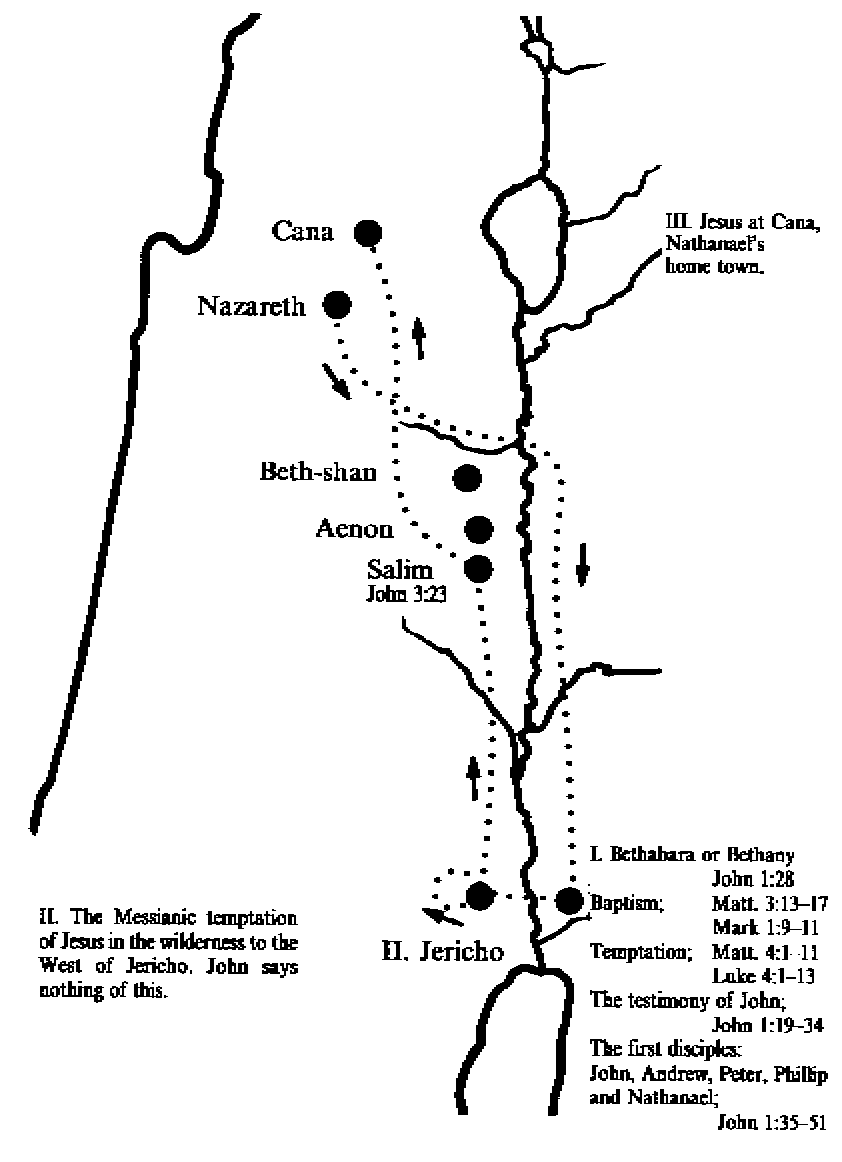 II. SPRING AD 27
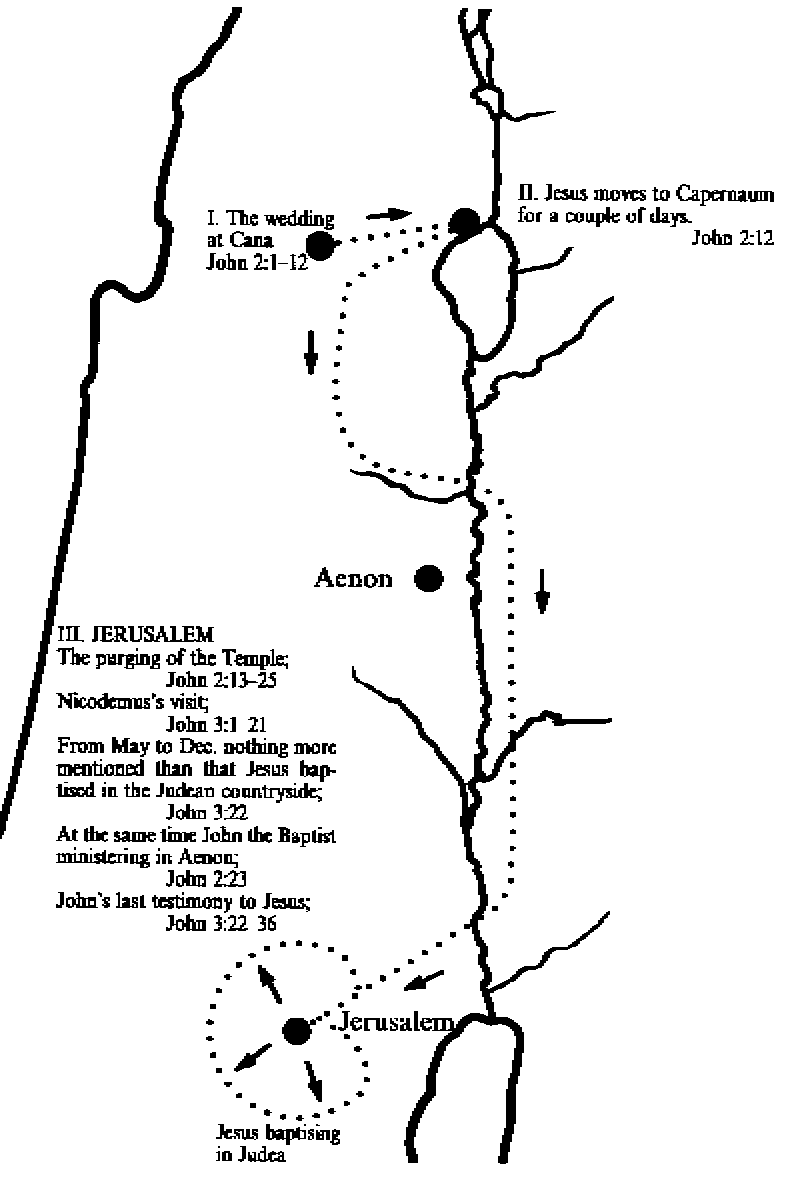 III. WINTER AD 27--8 Only John tells us of the beginning of Jesus' ministry. 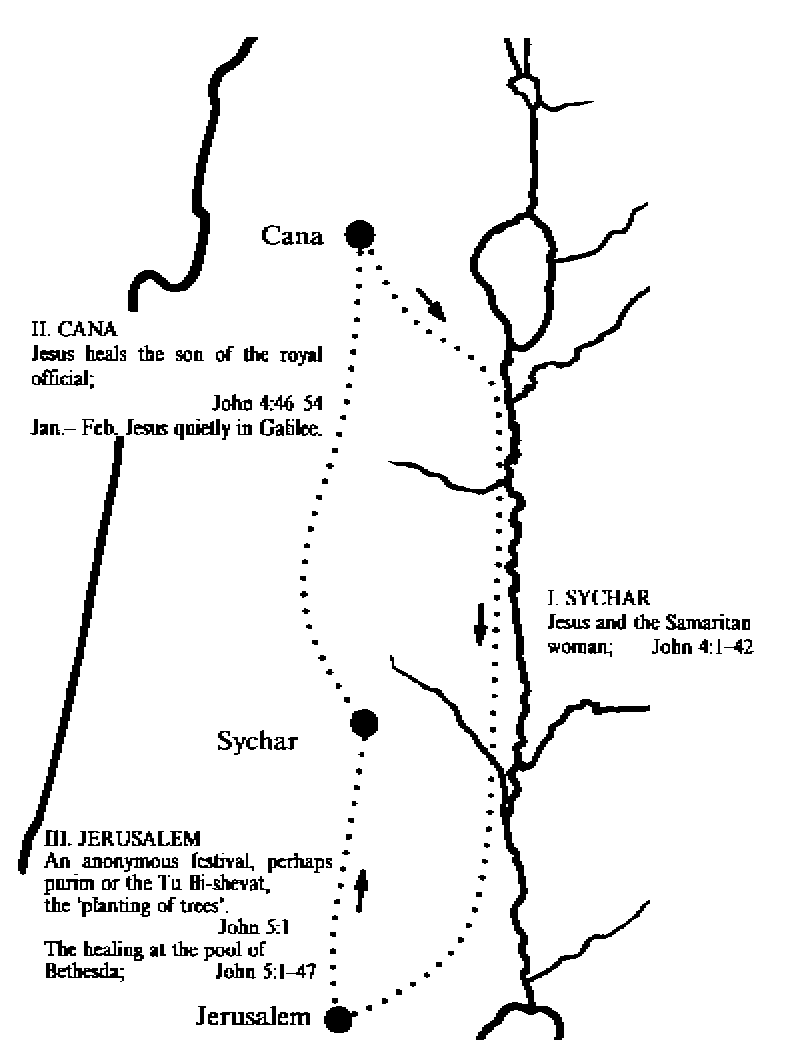 IV. SPRING AD 28 Jesus arrives in Galilee and settles down to live in Capernaum. Mark 1--3 and Luke 4--6 tell us of the early events in the Galilean ministry. 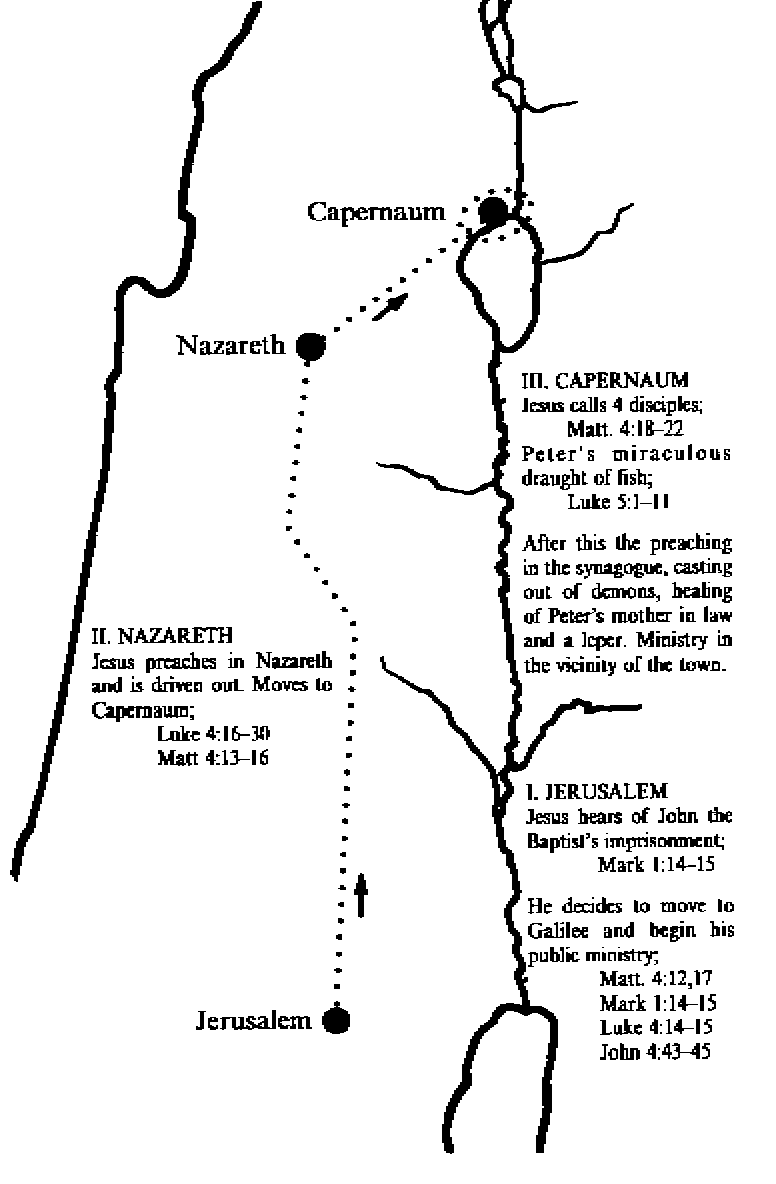 V. SUMMER AD 28
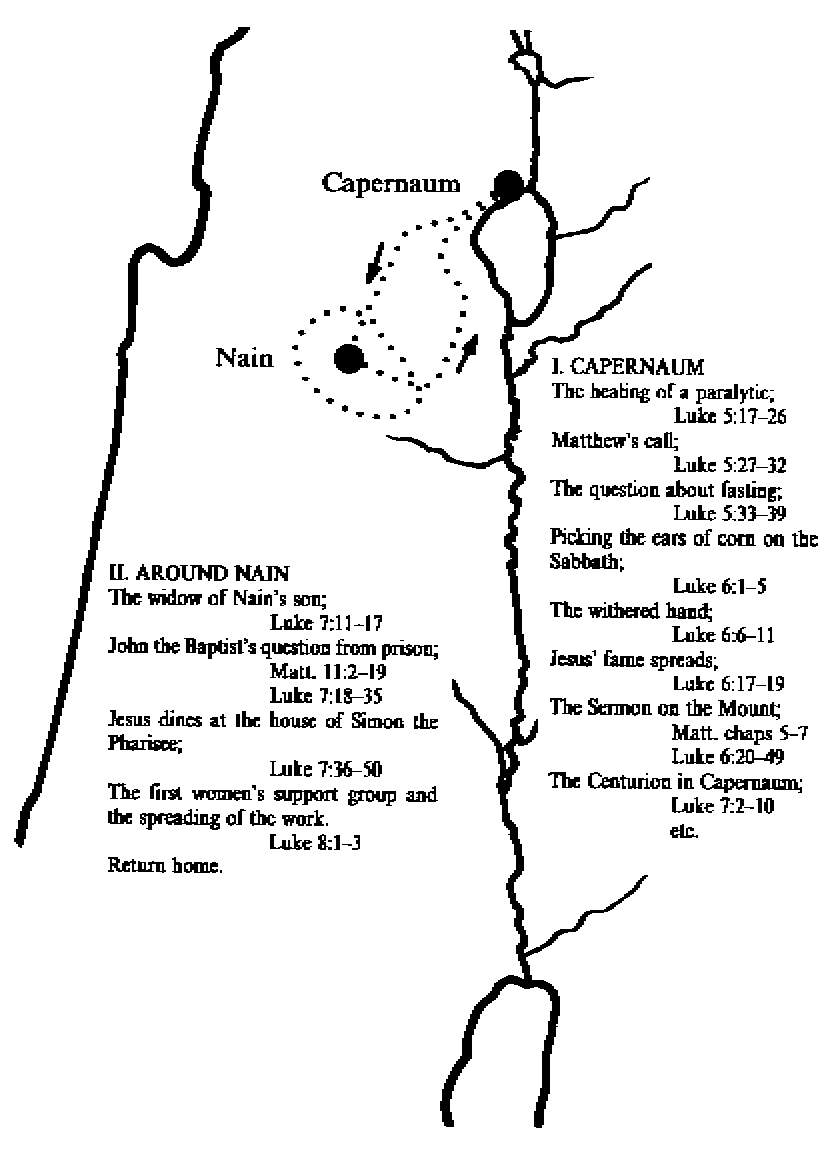 VI. AUTUMN AD 28
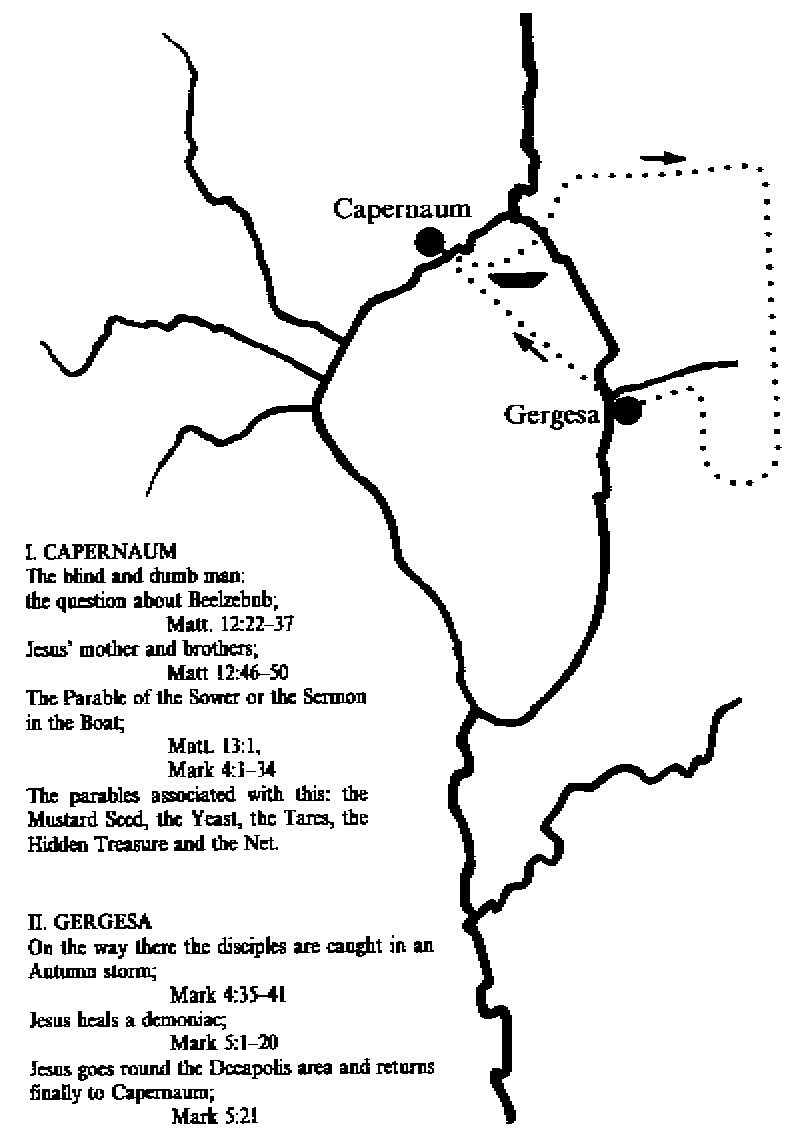 VII. WINTER AD 28--9 Jesus remains primarily in Capernaum, apart from a brief trip to Nazareth. He delegates responsibilities to his Apostles and hears of the execution of John the Baptist. 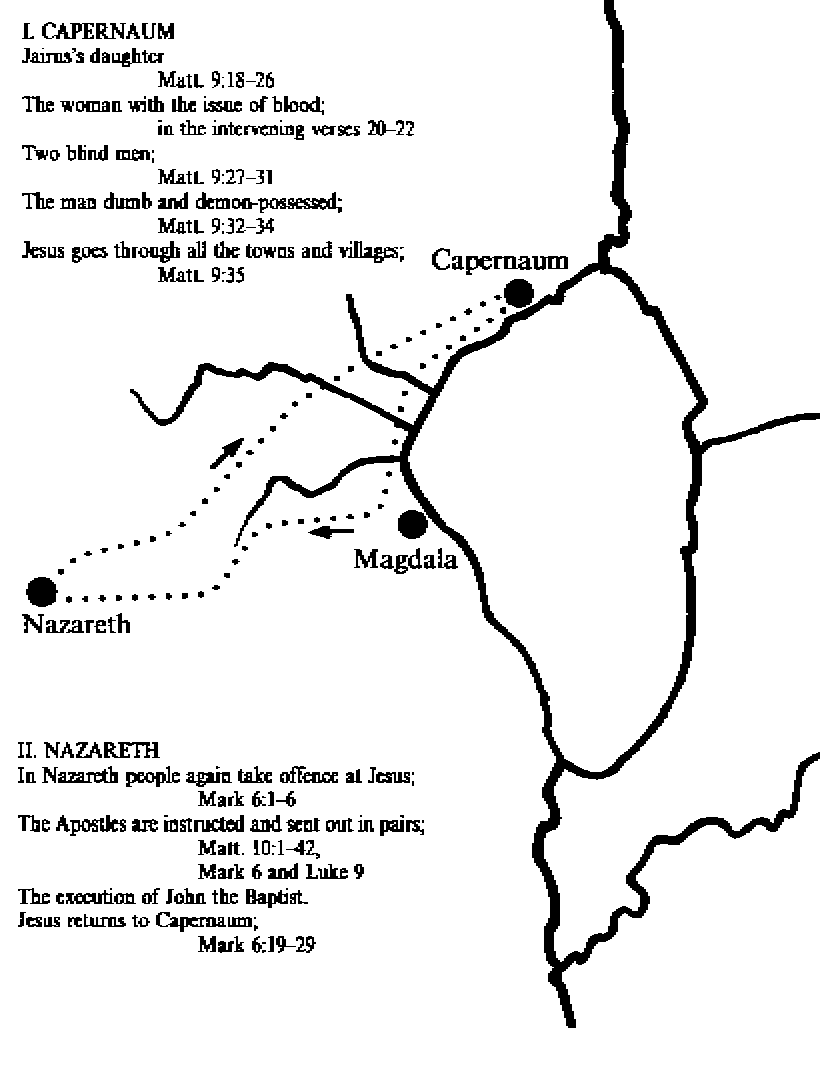 VIII. SPRING AD 29
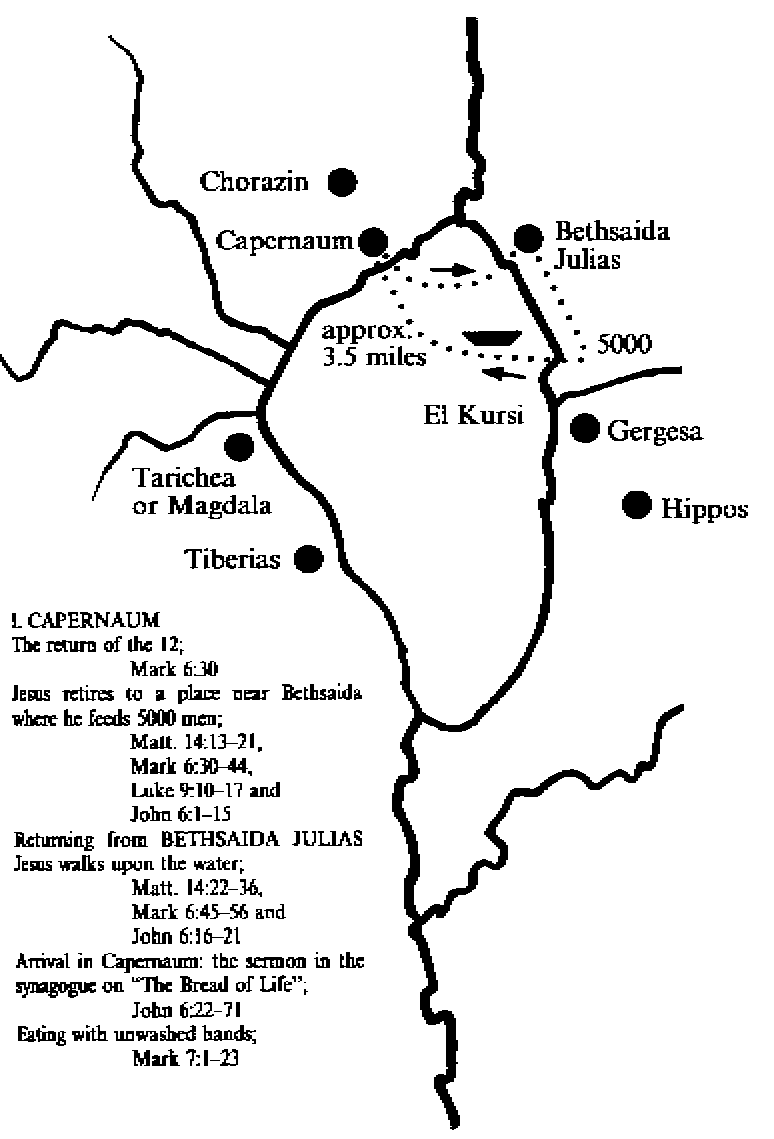 IX. SUMMER AD 29
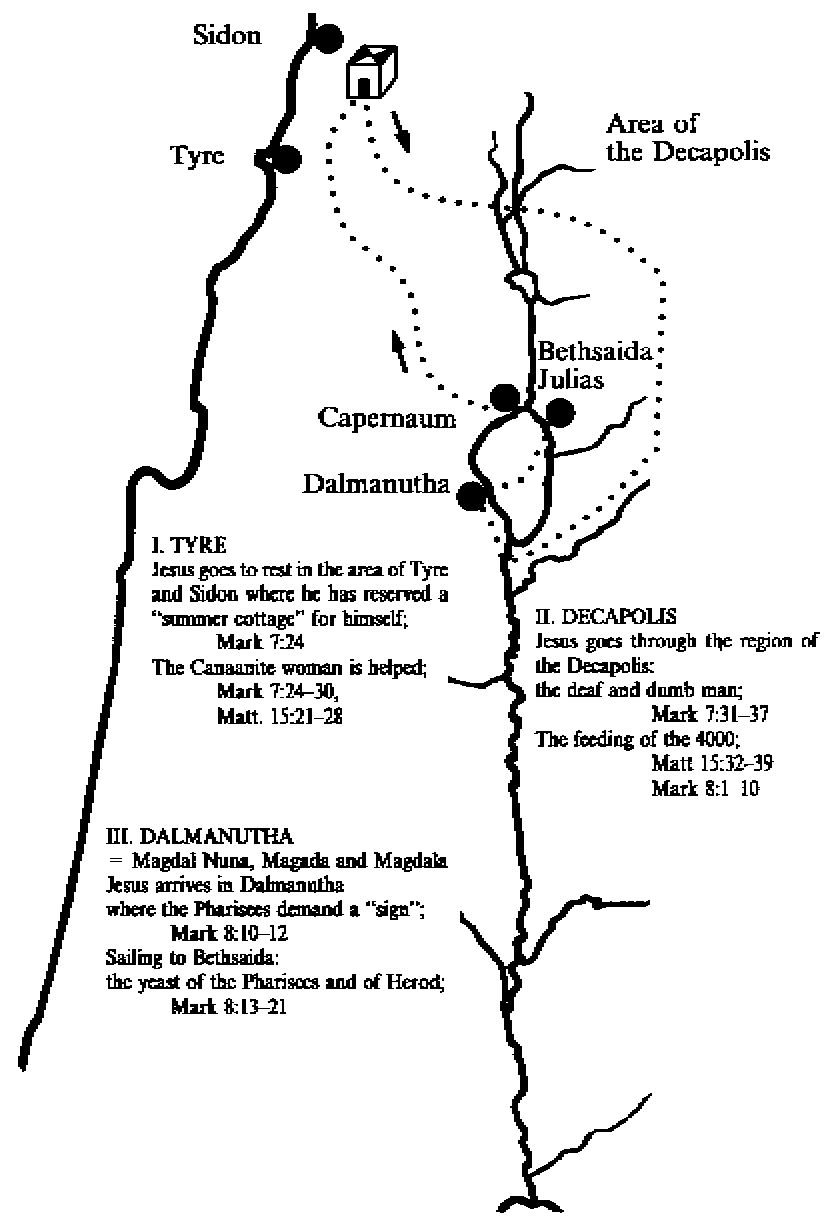 X. AUTUMN AD 29
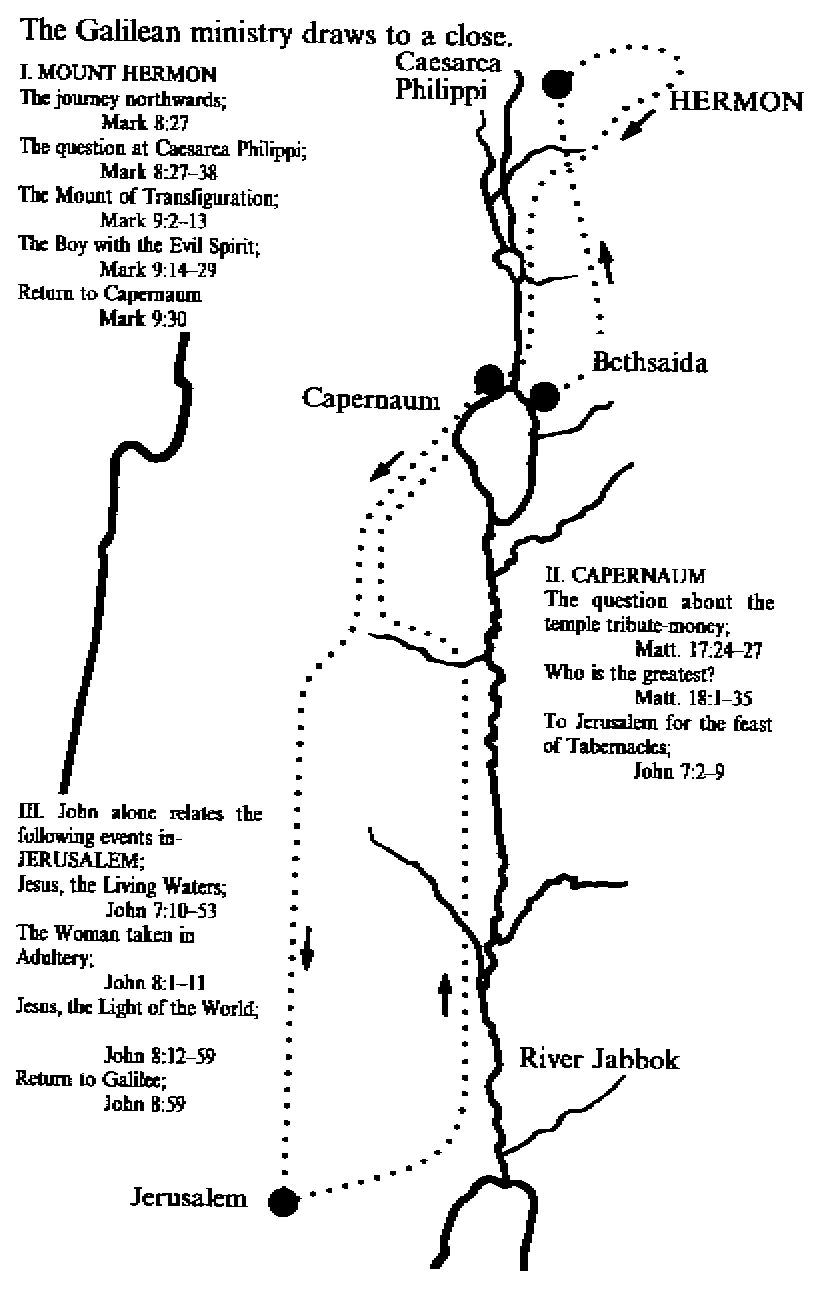 XI. WINTER AD 29
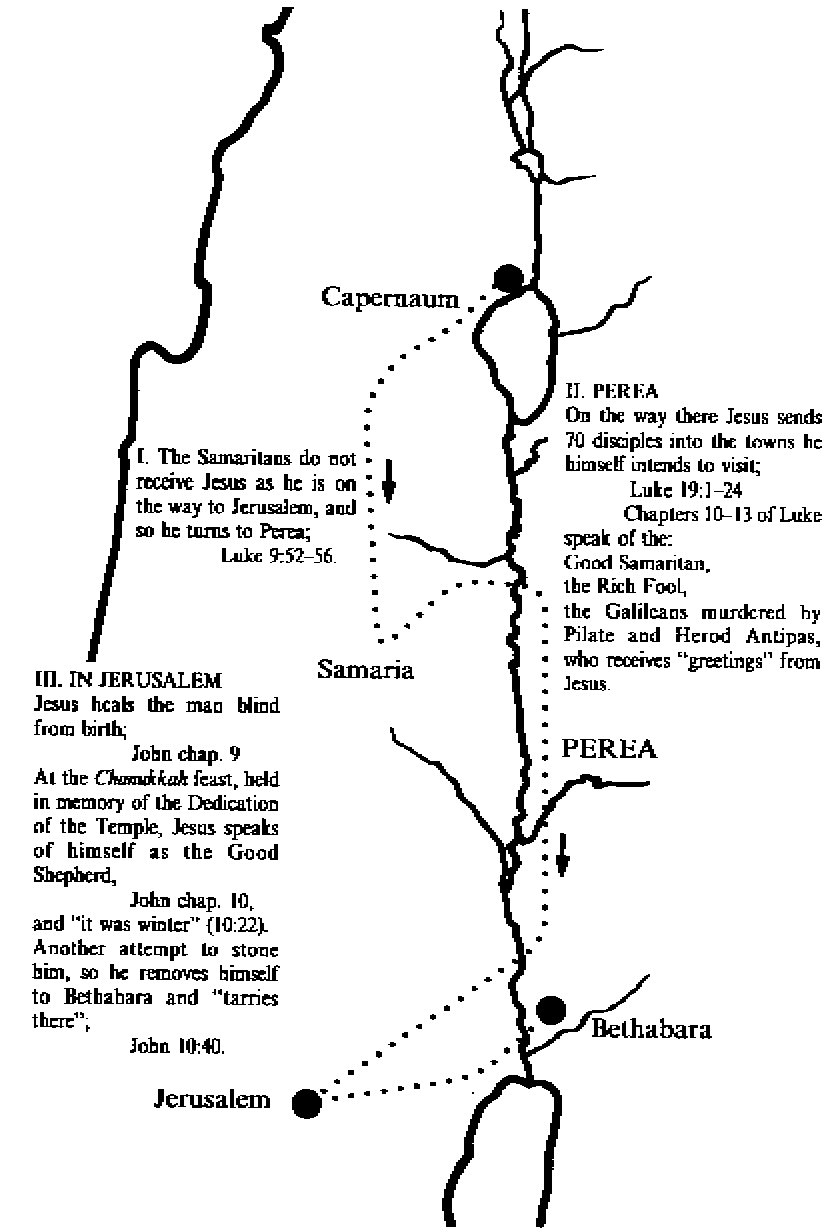 XII. WINTER -- SPRING AD 29
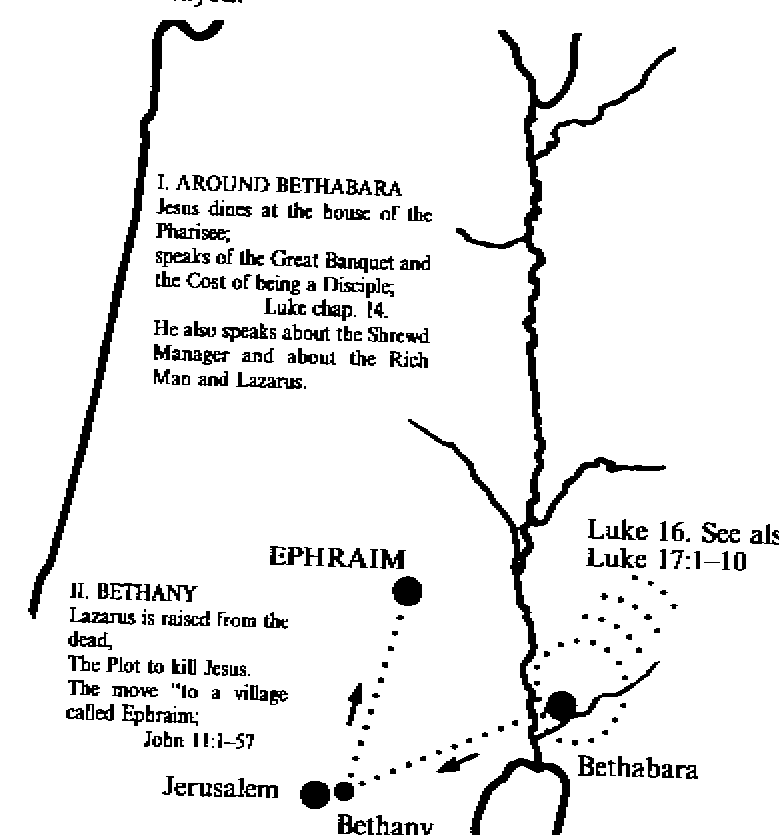 NOTE: The "Synoptic" gospels, Matthew, Mark and Luke, do not assume that Jesus' ministry in Perea was split into several stages. When John, however, states clearly that Jesus went to Jerusalem for the Feast of Chanukka and thereafter to Bethabara, Bethany and the area around Ephraim, this must be inserted in the narrative of the Synoptics. There is no reason to doubt the reliability of the information John provides. It should also be noted that the 12th to 17th chapters of Luke form an independent narrative which does not look to the other Synoptics for support. XIII. SPRING AD 30
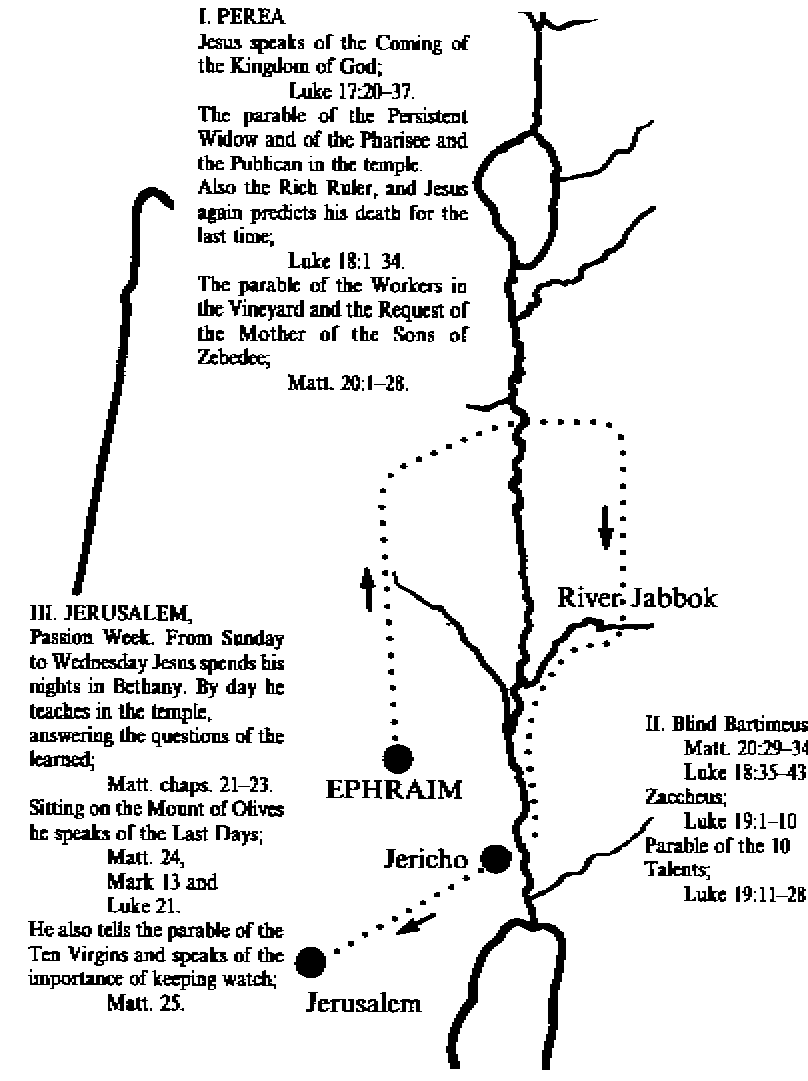 The dating of Jesus' ministry The ministries of Jesus and of John the Baptist dovetail with one another. Of John, mention is made that "he lived in the desert until he appeared publicly to Israel" (Luke 1:80). In the Greek, the word 'desert' is in the plural: John needed a long time of preparation for his ministry, and it would appear that he dwelt in several different places in the wilderness. Matthew locates him as preaching "in the Desert of Judea". He also baptised in different places; firstly in Bethany (called 'Bethabara' in some manuscripts), then in Aenon, near Salim (John 1:28 and 3:23). The question has been posed as to whether John had connections with the Essenes, contemporaneous with him. As far back as the 1880's, Edersheim pointed out that in both his dress and in his eating John differed from the Essenes. Even though the manuscripts found at Qumran say nothing in particular about the Essenes attire, Josephus tells us that they dressed in white. Josephus was also drawn to make note of John's unusual clothing, as we have already discussed. Mark describes him in more or less the same way when he says that he "wore clothing made of camel's hair, with a leather belt around his waist, and he ate locusts and wild honey" (1:6). It is telling that Jesus needed no special surroundings or unusual dress and eating habits in his preparation for ministry. He lived in his beloved Nazareth and devoted himself to his trade as a carpenter. Perhaps his father's early death put him in a position of responsibility towards his younger brothers and sisters. Only after his baptism did he withdraw to the desert for forty days and nights, where he fought out his call and went through the "Messianic birth-pangs" (Matt. 4:1-11, Mark 1:12-13 and Luke 4:1-13). In the final analysis, the issues at stake were, would he become a "bread king"? Did he hanker after an ecclesiastical career in his own Temple? Or would he embark on a political career? It is difficult to fathom the significance and profundity of these temptations. It would appear that right here at the outset he chose the lot of the Suffering Messiah. Of Jesus too we can say that his attitudes are very different from those of the Essenes. The Qumran brotherhood functioned as a movement in opposition to the Temple; Jesus, on the other hand, loved the House of God. The Essenes were even more strict than the Pharisees with regard to the Sabbath -- not even a close relative in danger of his life could be rescued on the Sabbath. They spoke a great deal about the use of violence in resisting evil, with the result that many Zealots, who relied on murder and terrorism, came from their ranks. They taught openly that one's enemies were to be hated; Jesus taught that we should love our enemies. An Essene was forbidden to enter the company of sinners; Jesus was the friend of sinners and even dwelt in their homes. Thus, we can take it as certain that Jesus neither lived amongst the Essenes nor went through any long probationary period before his call. Closely following the gospels, then, Jesus' ministry should be set within limits of 3-4 years. It was a continuation of the brief public appearance of John the Baptist. Luke 3:1-2 mentions six separate points of reference to which the ministries of Jesus and John can be historically anchored: when Tiberius was Emperor (AD 14- 37), Pontius Pilate Governor of Judea (AD 26-36), Herod Antipas Tetrarch of Galilee, his brother Philip Tetrarch of Iturea and Trachonitis, Lysanias Tetrarch of Abilene on the North side of the Hermon Mountains, and Annas and Caiaphas were functioning as High Priests. Quirinius' nominee Annas (AD 6-15) seems, after resigning from his post as high priest, to have functioned as president of the Sanhedrin (Acts 4:6) and as spiritual father to the Sadduccean priestly party. His son-in-law Caiaphas (AD 18-36) was Annas's puppet in everything. The Talmud tells us that Annas was guilty of one sin in particular, that of "whispering", referring on the one hand to the priesthood's extensive business activities, and on the other hand to the fact that Annas manipulated his contemporary representatives of justice. "Morality" in that age "was blighted, justice open to bribery, and the Holy Spirit had left Israel". To give a historical anchor-point, Luke chose these leading men from those who were in positions of power and influence during Jesus' public ministry. Luke says that "the word of God came to John" in the fifteenth year of the reign of Tiberius Caesar. Augustus died on the 19th of August AD 14, but for the two preceding years Tiberius had functioned as co-ruler. Alfred Edersheim refers to the fact that it was customary in the provinces to reckon the co-sovereignty period as part of the Emperor's reign, thus setting the commencement of John's ministry in AD 26. "According to earlier calculations", he adds, "Jesus was at that time thirty years of age."5 Luke does indeed say, in recounting the baptism of Jesus, that he was "about thirty years old when he began his ministry" (3:23). Another way of determining the date of the begining of Jesus' ministry is connected with the description in John ch. 2 of the Passover journey in the Spring following his baptism. Jesus speaks then of the destruction of the Temple and claims that he can raise it up in three days. The Jews say in astonishment, "It has taken forty-six years to build this Temple, and you are going to raise it in three days?" Herod began the building of the Temple in 19 BC, and if we count 46 years from then we conclude that Jesus must have said these words at Passover in the year 27 AD. Thus the historical references given by both John and Luke are in perfect accord. The ministries of John and Jesus spring naturally from an OT background. The New Testament critic Hugh J. Schonfield mentions that the "15th year of the reign of Tiberius" implies the Jewish calendar year which began in the latter half of September or the beginning of October AD 26, a Sabbatical year. This is proved simply by remembering that the difference between the Christian and Jewish eras is 3761 years, and that 3761+26 is divisible by 7. The Sabbatical year was also called the "year of liberation" (Deut. 31:10). The land was to rest, creditors were to cancel what was owed them, quarrels were to be settled and Hebrew slaves set free. Even if the Jews never fully observed the regulations for the Sabbatical year, they always, nevertheless, had time during its course to meet with each other. And it was a spiritual challenge (2 Chron. 36:21 and Neh. 10:32). Luke is the only one of the evangelists who details the content of John's preaching. The Baptist addresses various sections of his audience: ordinary people, tax-collectors and soldiers. From the ordinary folk he demanded improvements in their love for their neighbours, the tax-collectors and the soldiers he rebuked for exorbitant rates of interest and blackmail. It would seem obvious for John to choose the Sabbatical ordinances of Deuteronomy chapter 15 as the theme for his preaching. The Jews were forbidden to be "hard-hearted or tight-fisted" towards their poor brethren, rather, they were to "freely lend" whatever the poor needed. The creditor was to "cancel the loan he has made to his fellow Israelite". He was not allowed to "require payment from his fellow Israelite or brother, because the LORD's time for cancelling debts" had been proclaimed. A liberated slave was not to be sent away "empty-handed". "Supply him liberally from your flock, your threshing-floor and your wine-press." Although John might equaly lash out with his tongue about the axe at the root of the tree in order to effect repentance, he nevertheless "exhorted the people and preached the good news to them" (Luke 3:18). A third means of dating Jesus' ministry is the determination of the
year in which he died. Critics have not come to any agreement on this
matter and extensive studies have been written about it. Most agree that
Jesus was crucified at Passover in AD 30, when the 14th day of the Jewish
calendar month of Nisan fell on a Friday, as the gospels presuppose.6
On that day "the whole congregation of Israel" slaughtered one lamb per
family (Ex. 12:1-6). Studies in Astronomy confirm this fact.7
Understood thus, the dating of Jesus' ministry accords well with the joint
picture presented by the gospels.
|